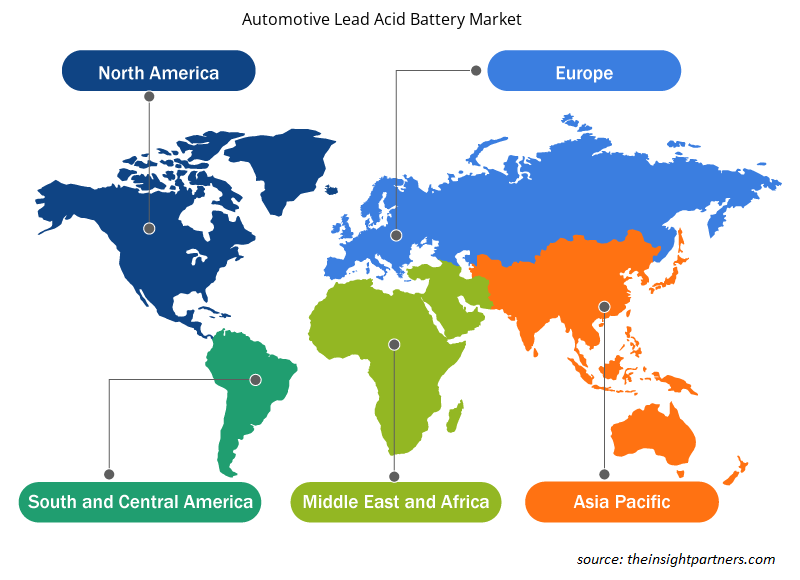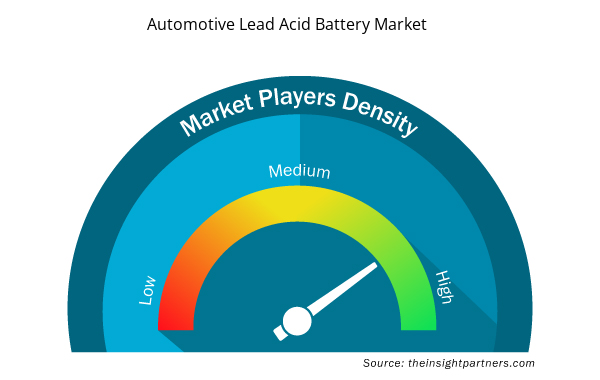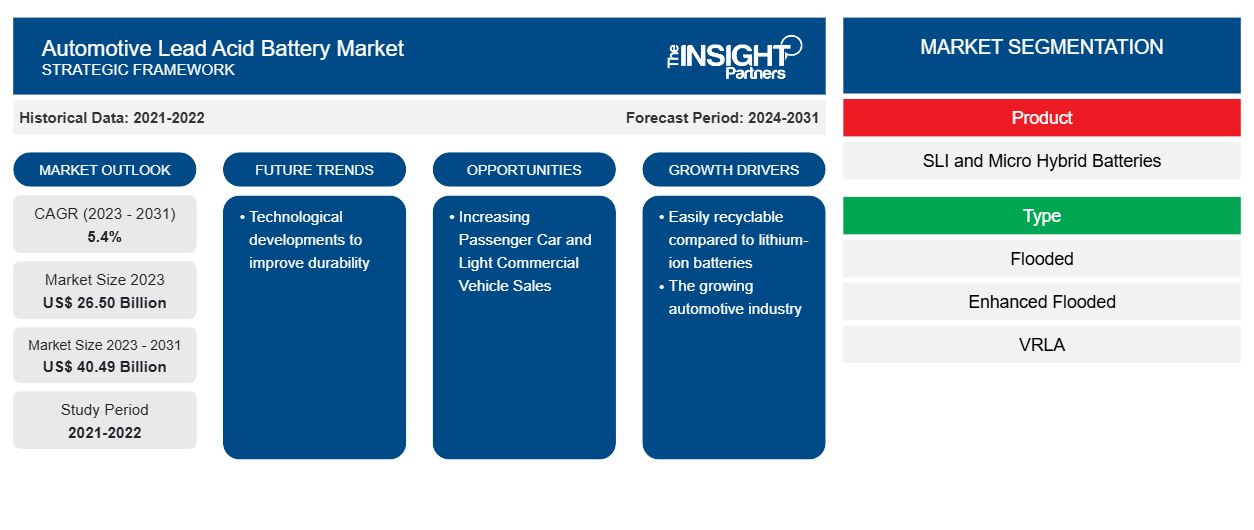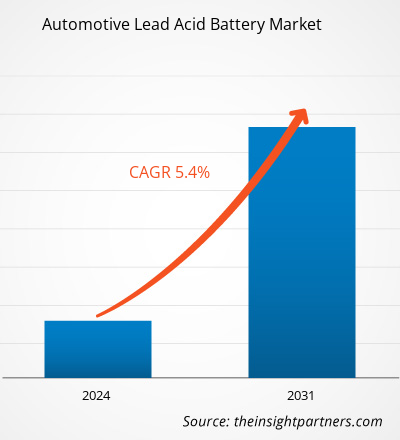Der Markt für Bleibatterien für Kraftfahrzeuge soll von 26,50 Milliarden US-Dollar im Jahr 2023 auf 40,49 Milliarden US-Dollar im Jahr 2031 wachsen; von 2023 bis 2031 wird eine durchschnittliche jährliche Wachstumsrate von 5,4 % erwartet. Die technologische Entwicklung zur Verbesserung der Haltbarkeit dürfte ein wichtiger Trend auf dem Markt sein.CAGR of 5.4% from 2023 to 2031. Technological development to improve durability is anticipated to be a key trend in the market.
Marktanalyse für Blei-Säure-Batterien für Kraftfahrzeuge
Im Vergleich zu anderen Arten wiederaufladbarer Batterien sind Bleibatterien günstiger. Die Selbstentladungsrate dieser Batterie beträgt etwa 40 % pro Jahr. Eine Bleibatterie funktioniert sowohl bei hohen als auch bei niedrigen Temperaturen einwandfrei. Die in diesen Batterien verwendete Technologie ist ausgereift. Bei ordnungsgemäßer Verwendung kann eine Bleibatterie lange halten und zuverlässig ihren Dienst verrichten. Bleibatterien können große Stoßströme liefern, was sie ideal für Anwendungen macht, die einen schnellen Stromstoß erfordern, wie z. B. Starterbatterien für Kraftfahrzeuge. Daher wird erwartet, dass die Nachfrage nach Bleibatterien für Kraftfahrzeuge im Prognosezeitraum steigen wird.
Branchenübersicht über den Markt für Blei-Säure-Batterien für Kraftfahrzeuge
Eine Blei-Säure-Autobatterie ist ein wiederaufladbares Gerät, das elektrische Energie als chemische Energie speichert. Sie besteht aus vielen in Reihe geschalteten Zellen, von denen jede eine Reihe von Bleidioxid- und Bleischwammplatten enthält, die in eine Schwefelsäurelösung getaucht sind. Blei-Säure-Batterien funktionieren in einer Vielzahl von Klimasituationen effektiv . Sie haben eine hohe Startleistung und liefern selbst bei extremen Temperaturen ausreichend Startstrom. Diese Eigenschaft macht Blei-Säure-Batterien zu einer ausgezeichneten Wahl für Autos sowohl in kalten als auch in heißen Klimazonen. Daher wird erwartet, dass die Nachfrage nach Blei-Säure-Batterien im Prognosezeitraum steigen wird.
Passen Sie diesen Bericht Ihren Anforderungen an
Sie erhalten kostenlose Anpassungen an jedem Bericht, einschließlich Teilen dieses Berichts oder einer Analyse auf Länderebene, eines Excel-Datenpakets sowie tolle Angebote und Rabatte für Start-ups und Universitäten.
- Holen Sie sich die wichtigsten Markttrends aus diesem Bericht.Dieses KOSTENLOSE Beispiel umfasst eine Datenanalyse von Markttrends bis hin zu Schätzungen und Prognosen.
Treiber und Chancen auf dem Markt für Bleibatterien für Kraftfahrzeuge
Bleibatterien sind im Vergleich zu Lithium-Ionen-Batterien leicht recycelbar, was das Marktwachstum fördert.
Beim Batterierecycling wird die Schwefelsäure aus gebrauchten Batterien sorgfältig entfernt und neutralisiert. Dieses Verfahren begrenzt den Ausstoß gefährlicher Schwefelsäure in die Umwelt und verringert die Gefahr einer Boden- und Wasserverschmutzung. Lithium-Ionen-Batterien enthalten keine giftigen Chemikalien, Blei-Säure-Batterien hingegen schon. Beide Batterietypen sind recycelbar. Blei-Säure-Batterien lassen sich jedoch in den meisten Teilen der Welt leichter recyceln als Lithium-Ionen-Batterien. Etwa 95 % der Materialien in Blei-Säure-Batterien sind recycelbar, was sie zu einer umweltfreundlichen Wahl macht. Daher wird erwartet, dass die Nachfrage nach Blei-Säure-Batterien im Prognosezeitraum steigen wird.
Steigende Pkw- und Nutzfahrzeugverkäufe
Laut dem in der Economic Times veröffentlichten Artikel erreichte der Pkw-Großhandel in Indien im Geschäftsjahr 2023–24 einen neuen Höchststand von 42.187.46 Einheiten. Darüber hinaus erreichten Chinas Nutzfahrzeugexporte laut der China Association of Automobile Manufacturers im Januar 2024 74.000 Einheiten. Bleibatterien werden für Start, Beleuchtung und Zündung (SLI) in einem Automobil bevorzugt. Daher wird erwartet, dass der steigende Absatz von Personenkraftwagen und leichten Nutzfahrzeugen die Nachfrage nach Bleibatterien im Prognosezeitraum steigern wird.SLI) in an automobile. Thus, increasing sales of passenger and light
Segmentierungsanalyse des Marktberichts für Blei-Säure-Batterien für Kraftfahrzeuge
Die Schlüsselsegmente, die zur Ableitung der Marktanalyse für Bleibatterien für Kraftfahrzeuge beigetragen haben, sind Produkt und Endbenutzer.
- Je nach Produkt wird der Markt in SLI- und Mikro-Hybrid-Batterien unterteilt.SLI and micro-hybrid batteries.
- je nach Typ ist der Markt in geflutete, verstärkte geflutete und VRLA segmentiert)VRLA)
- Basierend auf den Endnutzern ist der Markt in Personenkraftwagen, leichte Nutzfahrzeuge, mittelgroße Nutzfahrzeuge und schwere Nutzfahrzeuge segmentiert.
- Im Jahr 2023 hatte das SLI-Segment einen bedeutenden Marktanteil. Die SLI-Batterie ist eine wiederaufladbare Blei-Säure-Batterie und wird häufig in verschiedenen Automobilen verwendet.
Marktanteilsanalyse für Blei-Säure-Batterien für Kraftfahrzeuge nach geografischen Gesichtspunkten
Regional ist der Markt in Nordamerika, Europa, Asien-Pazifik, Naher Osten und Afrika sowie Süd- und Mittelamerika segmentiert.
Europas starke Position bei Innovationen und Umweltschutzmaßnahmen im Automobilbereich hat erhebliche Auswirkungen auf die Bleibatterieindustrie für Kraftfahrzeuge. Deutschland, Großbritannien und Frankreich werden voraussichtlich die wichtigsten Länder auf dem europäischen Markt für Bleibatterien für Kraftfahrzeuge sein. Andererseits wird erwartet, dass der asiatisch-pazifische Raum im Prognosezeitraum aufgrund des Wachstums des Automobilsektors in der Region der profitabelste Markt sein wird.
Regionale Einblicke in den Markt für Blei-Säure-Batterien für Kraftfahrzeuge
Die regionalen Trends und Faktoren, die den Markt für Bleibatterien für Kraftfahrzeuge im gesamten Prognosezeitraum beeinflussen, wurden von den Analysten von Insight Partners ausführlich erläutert. In diesem Abschnitt werden auch die Marktsegmente und die Geografie für Bleibatterien für Kraftfahrzeuge in Nordamerika, Europa, im asiatisch-pazifischen Raum, im Nahen Osten und Afrika sowie in Süd- und Mittelamerika erörtert.

- Erhalten Sie regionale Daten zum Markt für Bleibatterien für Kraftfahrzeuge
Umfang des Marktberichts über Bleibatterien für Kraftfahrzeuge
| Berichtsattribut | Details |
|---|---|
| Marktgröße im Jahr 2023 | 26,50 Milliarden US-Dollar |
| Marktgröße bis 2031 | 40,49 Milliarden US-Dollar |
| Globale CAGR (2023 - 2031) | 5,4 % |
| Historische Daten | 2021-2022 |
| Prognosezeitraum | 2024–2031 |
| Abgedeckte Segmente | Nach Produkt
|
| Abgedeckte Regionen und Länder | Nordamerika
|
| Marktführer und wichtige Unternehmensprofile |
|
Marktteilnehmerdichte für Bleibatterien für Kraftfahrzeuge: Auswirkungen auf die Geschäftsdynamik verstehen
Der Markt für Bleibatterien für Kraftfahrzeuge wächst rasant. Dies wird durch die steigende Nachfrage der Endverbraucher aufgrund von Faktoren wie sich entwickelnden Verbraucherpräferenzen, technologischen Fortschritten und einem größeren Bewusstsein für die Vorteile des Produkts vorangetrieben. Mit der steigenden Nachfrage erweitern Unternehmen ihr Angebot, entwickeln Innovationen, um die Bedürfnisse der Verbraucher zu erfüllen, und nutzen neue Trends, was das Marktwachstum weiter ankurbelt.
Die Marktteilnehmerdichte bezieht sich auf die Verteilung der Firmen oder Unternehmen, die in einem bestimmten Markt oder einer bestimmten Branche tätig sind. Sie gibt an, wie viele Wettbewerber (Marktteilnehmer) in einem bestimmten Marktraum im Verhältnis zu seiner Größe oder seinem gesamten Marktwert präsent sind.
Die wichtigsten auf dem Markt für Bleibatterien für Kraftfahrzeuge tätigen Unternehmen sind:
- Clarios
- CSB Energietechnik Co., Ltd.
- EnerSys
- East Penn Fertigungsunternehmen
- Exide Industries Limited
- GS Yuasa International Ltd.
Haftungsausschluss : Die oben aufgeführten Unternehmen sind nicht in einer bestimmten Reihenfolge aufgeführt.

- Überblick über die wichtigsten Akteure auf dem Markt für Bleibatterien für Kraftfahrzeuge
Nachrichten und aktuelle Entwicklungen zum Markt für Bleibatterien für Kraftfahrzeuge
Der Markt für Bleibatterien für Kraftfahrzeuge wird durch die Erhebung qualitativer und quantitativer Daten nach Primär- und Sekundärforschung bewertet, die wichtige Unternehmensveröffentlichungen, Verbandsdaten und Datenbanken umfasst. Nachfolgend sind einige der Entwicklungen im Bereich der Bleibatterien für Kraftfahrzeuge aufgeführt:
- GS Yuasa Corporation gab bekannt, dass das in Indien ansässige Unternehmen Tata AutoComp GY Batteries Private Ltd. („TGY“), ein nach der Equity-Methode bilanziertes Tochterunternehmen der Tochtergesellschaft GS Yuasa International Ltd. („GS Yuasa“), seine jährliche Produktionskapazität für Blei-Säure-Batterien für Motorräder auf 8,4 Millionen Einheiten verdoppeln will. Darüber hinaus wird TGY seine Produktion von Blei-Säure-Batterien für Autos verstärken, wobei der Schwerpunkt auf Hochleistungs-Blei-Säure-Batterien für umweltfreundliche Fahrzeuge wie Start-Stopp-Fahrzeuge liegt, deren Nachfrage in den kommenden Jahren voraussichtlich weiter steigen wird. (Quelle: GS Yuasa Corporation, Pressemitteilung, Dezember 2021)
Marktbericht zu Blei-Säure-Batterien für Kraftfahrzeuge – Abdeckung und Ergebnisse
Die Marktprognose für Blei-Säure-Batterien für Kraftfahrzeuge wird auf der Grundlage verschiedener sekundärer und primärer Forschungsergebnisse geschätzt, wie z. B. wichtiger Unternehmensveröffentlichungen, Verbandsdaten und Datenbanken. Der Marktbericht „Marktgröße und Prognose für Blei-Säure-Batterien für Kraftfahrzeuge (2021–2031)“ bietet eine detaillierte Analyse des Marktes, die die folgenden Bereiche abdeckt:
- Marktgröße und Prognose für Bleibatterien für Kraftfahrzeuge auf globaler, regionaler und Länderebene für alle wichtigen Marktsegmente, die im Rahmen des Berichts abgedeckt sind
- Markttrends für Bleibatterien für Kraftfahrzeuge sowie Marktdynamiken wie Treiber, Einschränkungen und wichtige Chancen
- Detaillierte PEST/Porters Five Forces- und SWOT-Analyse
- Marktanalyse für Bleibatterien für Kraftfahrzeuge mit Blick auf wichtige Markttrends, globale und regionale Rahmenbedingungen, wichtige Akteure, Vorschriften und aktuelle Marktentwicklungen
- Branchenlandschaft und Wettbewerbsanalyse, die die Marktkonzentration, Heatmap-Analyse, prominente Akteure und aktuelle Entwicklungen auf dem Markt für Bleibatterien für Kraftfahrzeuge umfasst
- Detaillierte Firmenprofile.
- Historische Analyse (2 Jahre), Basisjahr, Prognose (7 Jahre) mit CAGR
- PEST- und SWOT-Analyse
- Marktgröße Wert/Volumen – Global, Regional, Land
- Branche und Wettbewerbsumfeld
- Excel-Datensatz


- Electronic Data Interchange Market
- Mesotherapy Market
- Asset Integrity Management Market
- Non-Emergency Medical Transportation Market
- Cosmetic Bioactive Ingredients Market
- USB Device Market
- Single Pair Ethernet Market
- Print Management Software Market
- Human Microbiome Market
- Emergency Department Information System (EDIS) Market

Report Coverage
Revenue forecast, Company Analysis, Industry landscape, Growth factors, and Trends

Segment Covered
This text is related
to segments covered.

Regional Scope
North America, Europe, Asia Pacific, Middle East & Africa, South & Central America

Country Scope
This text is related
to country scope.
Häufig gestellte Fragen
The automotive lead acid battery market size is projected to reach US$ 40.49 billion by 2031.
North America is expected to dominate the automotive lead acid battery market with the highest market share in 2023.
Technological developments to improve durability to play a significant role in the global automotive lead acid battery market in the coming years.
The leading players operating in the automotive lead acid battery market are Clarios, CSB Energy Technology Co., Ltd., EnerSys, East Penn Manufacturing Company, Exide Industries Limited, GS Yuasa International Ltd., Johnson Controls, Inc., leach International Technology Limited Inc., and Panasonic Corporation.
Easily recyclable compared to lithium-ion batteries and the growing automotive industry are the major factors driving the Automotive Lead Acid Battery market.
The global automotive lead acid battery market is expected to grow at a CAGR of 5.4 % during the forecast period 2024 - 2031.
Trends and growth analysis reports related to Electronics and Semiconductor : READ MORE..
The Insight Partners performs research in 4 major stages: Data Collection & Secondary Research, Primary Research, Data Analysis and Data Triangulation & Final Review.
- Data Collection and Secondary Research:
As a market research and consulting firm operating from a decade, we have published and advised several client across the globe. First step for any study will start with an assessment of currently available data and insights from existing reports. Further, historical and current market information is collected from Investor Presentations, Annual Reports, SEC Filings, etc., and other information related to company’s performance and market positioning are gathered from Paid Databases (Factiva, Hoovers, and Reuters) and various other publications available in public domain.
Several associations trade associates, technical forums, institutes, societies and organization are accessed to gain technical as well as market related insights through their publications such as research papers, blogs and press releases related to the studies are referred to get cues about the market. Further, white papers, journals, magazines, and other news articles published in last 3 years are scrutinized and analyzed to understand the current market trends.
- Primary Research:
The primarily interview analysis comprise of data obtained from industry participants interview and answers to survey questions gathered by in-house primary team.
For primary research, interviews are conducted with industry experts/CEOs/Marketing Managers/VPs/Subject Matter Experts from both demand and supply side to get a 360-degree view of the market. The primary team conducts several interviews based on the complexity of the markets to understand the various market trends and dynamics which makes research more credible and precise.
A typical research interview fulfils the following functions:
- Provides first-hand information on the market size, market trends, growth trends, competitive landscape, and outlook
- Validates and strengthens in-house secondary research findings
- Develops the analysis team’s expertise and market understanding
Primary research involves email interactions and telephone interviews for each market, category, segment, and sub-segment across geographies. The participants who typically take part in such a process include, but are not limited to:
- Industry participants: VPs, business development managers, market intelligence managers and national sales managers
- Outside experts: Valuation experts, research analysts and key opinion leaders specializing in the electronics and semiconductor industry.
Below is the breakup of our primary respondents by company, designation, and region:

Once we receive the confirmation from primary research sources or primary respondents, we finalize the base year market estimation and forecast the data as per the macroeconomic and microeconomic factors assessed during data collection.
- Data Analysis:
Once data is validated through both secondary as well as primary respondents, we finalize the market estimations by hypothesis formulation and factor analysis at regional and country level.
- Macro-Economic Factor Analysis:
We analyse macroeconomic indicators such the gross domestic product (GDP), increase in the demand for goods and services across industries, technological advancement, regional economic growth, governmental policies, the influence of COVID-19, PEST analysis, and other aspects. This analysis aids in setting benchmarks for various nations/regions and approximating market splits. Additionally, the general trend of the aforementioned components aid in determining the market's development possibilities.
- Country Level Data:
Various factors that are especially aligned to the country are taken into account to determine the market size for a certain area and country, including the presence of vendors, such as headquarters and offices, the country's GDP, demand patterns, and industry growth. To comprehend the market dynamics for the nation, a number of growth variables, inhibitors, application areas, and current market trends are researched. The aforementioned elements aid in determining the country's overall market's growth potential.
- Company Profile:
The “Table of Contents” is formulated by listing and analyzing more than 25 - 30 companies operating in the market ecosystem across geographies. However, we profile only 10 companies as a standard practice in our syndicate reports. These 10 companies comprise leading, emerging, and regional players. Nonetheless, our analysis is not restricted to the 10 listed companies, we also analyze other companies present in the market to develop a holistic view and understand the prevailing trends. The “Company Profiles” section in the report covers key facts, business description, products & services, financial information, SWOT analysis, and key developments. The financial information presented is extracted from the annual reports and official documents of the publicly listed companies. Upon collecting the information for the sections of respective companies, we verify them via various primary sources and then compile the data in respective company profiles. The company level information helps us in deriving the base number as well as in forecasting the market size.
- Developing Base Number:
Aggregation of sales statistics (2020-2022) and macro-economic factor, and other secondary and primary research insights are utilized to arrive at base number and related market shares for 2022. The data gaps are identified in this step and relevant market data is analyzed, collected from paid primary interviews or databases. On finalizing the base year market size, forecasts are developed on the basis of macro-economic, industry and market growth factors and company level analysis.
- Data Triangulation and Final Review:
The market findings and base year market size calculations are validated from supply as well as demand side. Demand side validations are based on macro-economic factor analysis and benchmarks for respective regions and countries. In case of supply side validations, revenues of major companies are estimated (in case not available) based on industry benchmark, approximate number of employees, product portfolio, and primary interviews revenues are gathered. Further revenue from target product/service segment is assessed to avoid overshooting of market statistics. In case of heavy deviations between supply and demand side values, all thes steps are repeated to achieve synchronization.
We follow an iterative model, wherein we share our research findings with Subject Matter Experts (SME’s) and Key Opinion Leaders (KOLs) until consensus view of the market is not formulated – this model negates any drastic deviation in the opinions of experts. Only validated and universally acceptable research findings are quoted in our reports.
We have important check points that we use to validate our research findings – which we call – data triangulation, where we validate the information, we generate from secondary sources with primary interviews and then we re-validate with our internal data bases and Subject matter experts. This comprehensive model enables us to deliver high quality, reliable data in shortest possible time.


 Holen Sie sich ein kostenloses Muster für diesen Bericht
Holen Sie sich ein kostenloses Muster für diesen Bericht